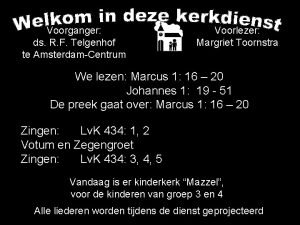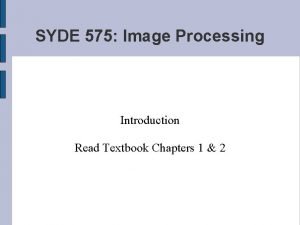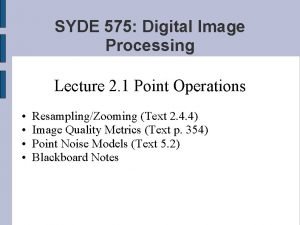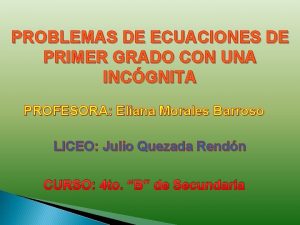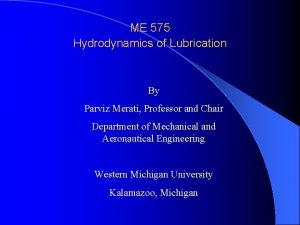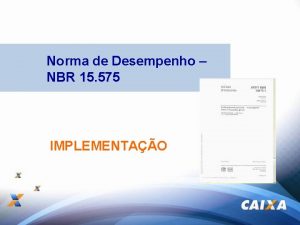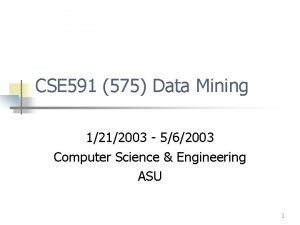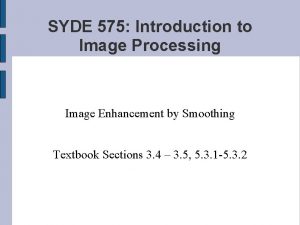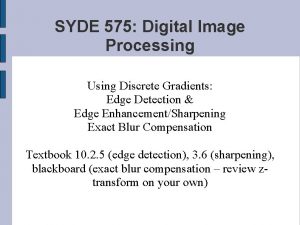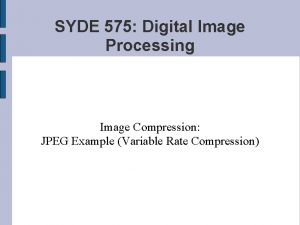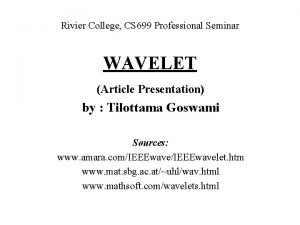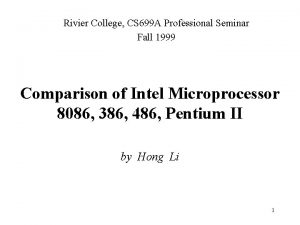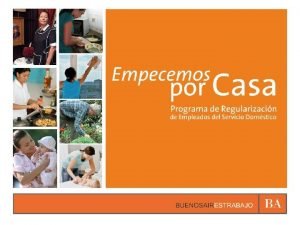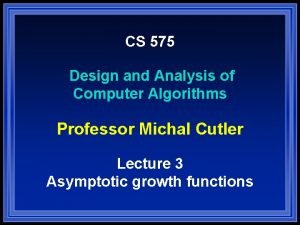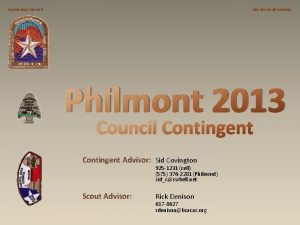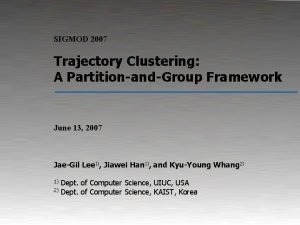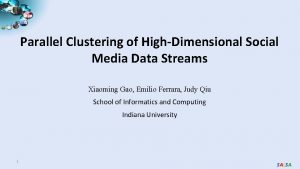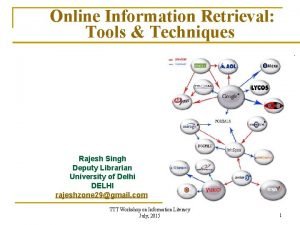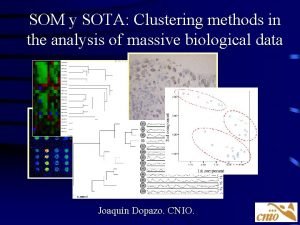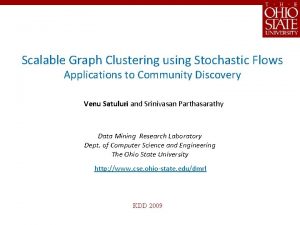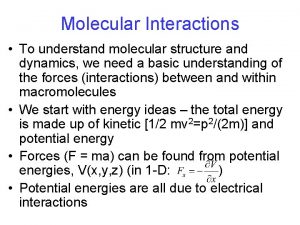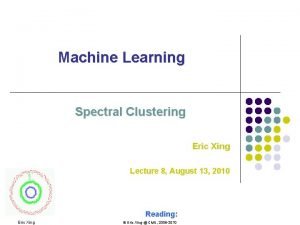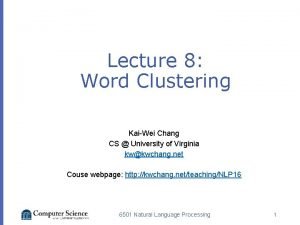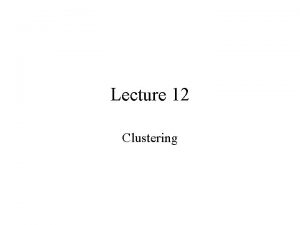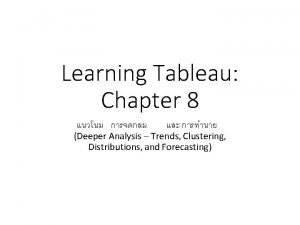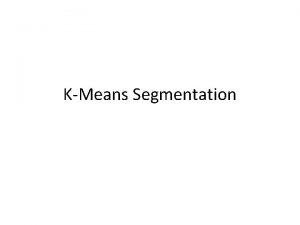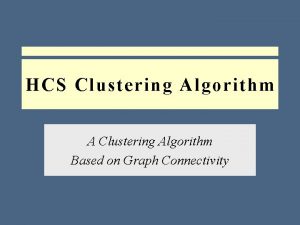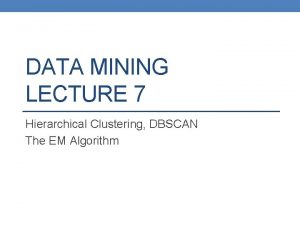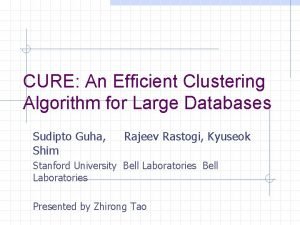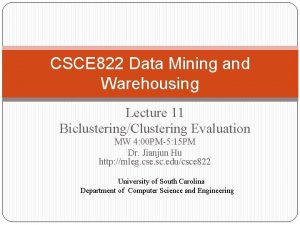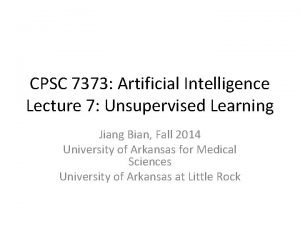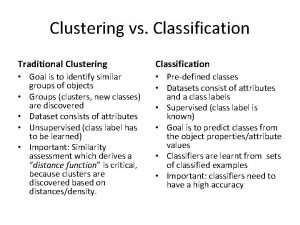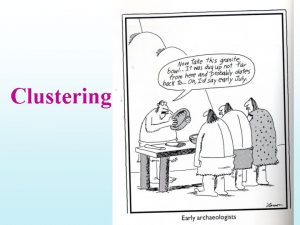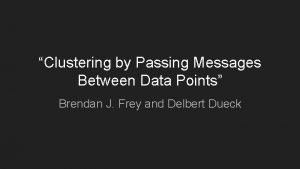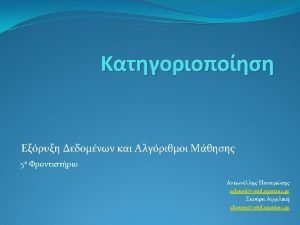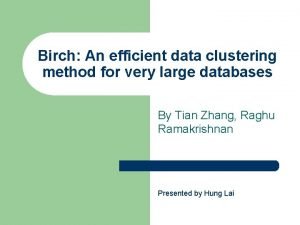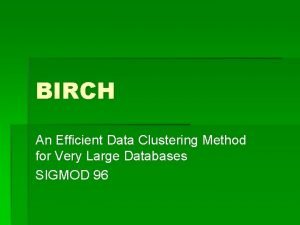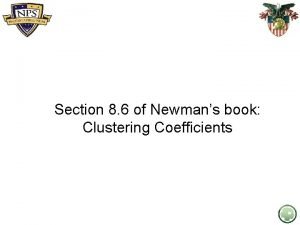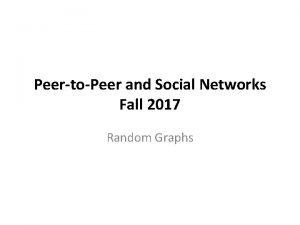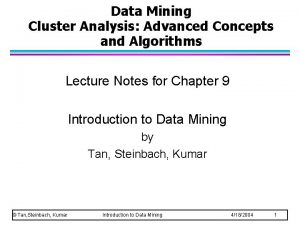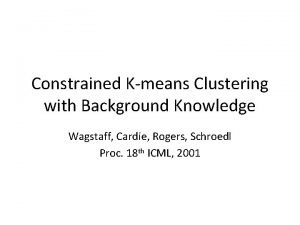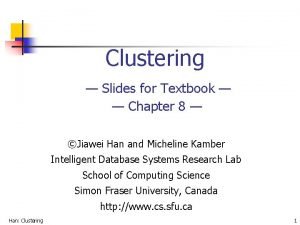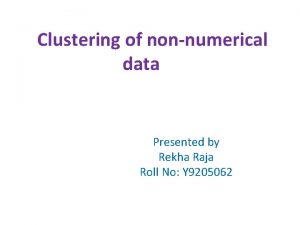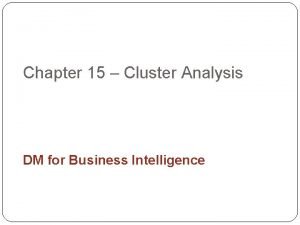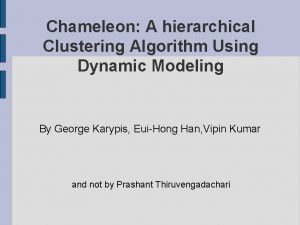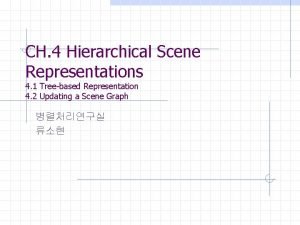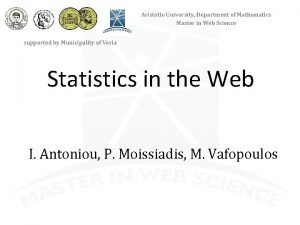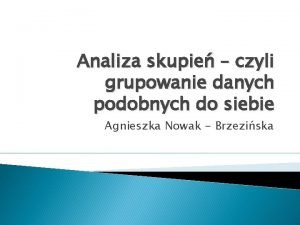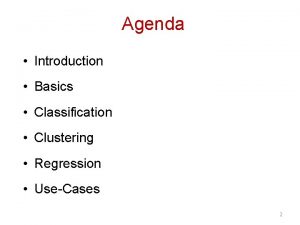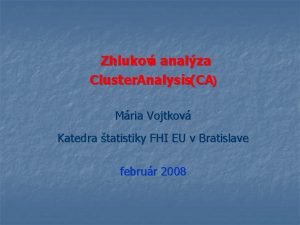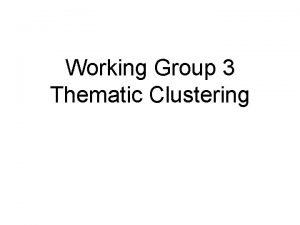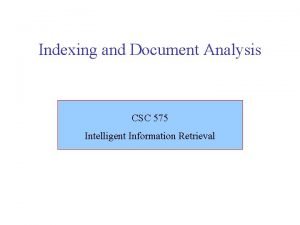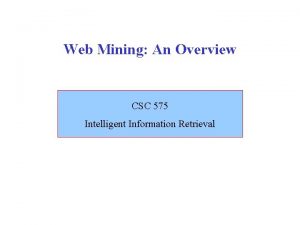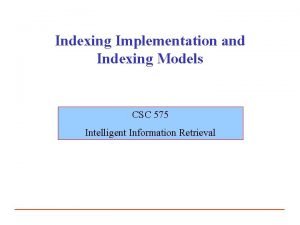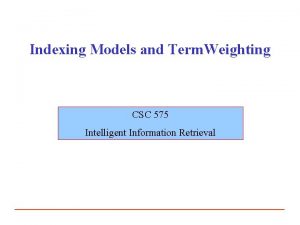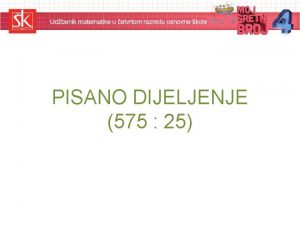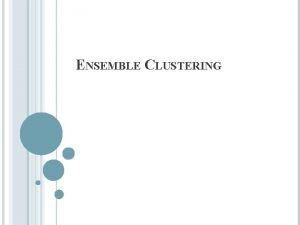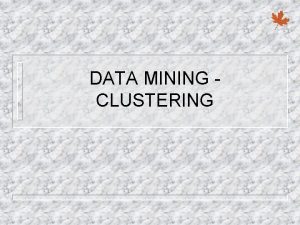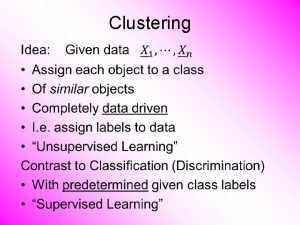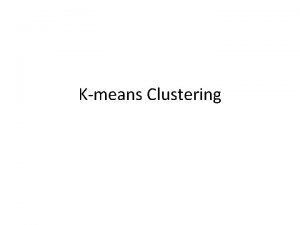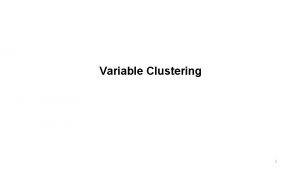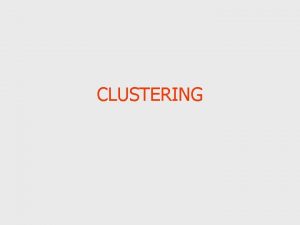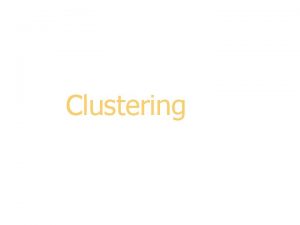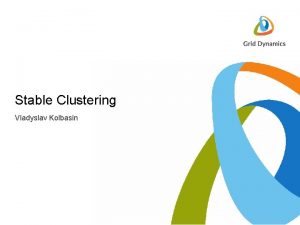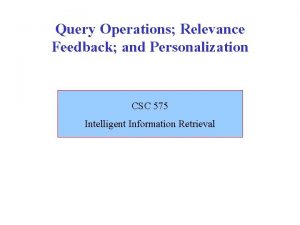Clustering Techniques and IR CSC 575 Intelligent Information


































































- Slides: 66

Clustering Techniques and IR CSC 575 Intelligent Information Retrieval

Clustering Techniques and IR i. Today 4 Clustering Problem and Applications 4 Clustering Methodologies and Techniques 4 Applications of Clustering in IR Intelligent Information Retrieval 2

What is Clustering? Clustering is a process of partitioning a set of data (or objects) in a set of meaningful sub-classes, called clusters Helps users understand the natural grouping or structure in a data set i Cluster: 4 a collection of data objects that are “similar” to one another and thus can be treated collectively as one group 4 but as a collection, they are sufficiently different from other groups Intelligent Information Retrieval 3

Clustering in IR i Objective of Clustering 4 assign items to automatically created groups based on similarity or association between items and groups 4 also called “automatic classification” 4 “The art of finding groups in data. ” -- Kaufmann and Rousseu i Clustering in IR 4 automatic thesaurus generation by clustering related terms 4 automatic concept indexing (concepts are clusters of terms) 4 automatic categorization of documents 4 information presentation and browsing 4 query generation and search refinement Intelligent Information Retrieval 4

Applications of Clustering i Clustering has wide applications in Pattern Recognition i Spatial Data Analysis / Image processing: 4 create thematic maps in GIS by clustering feature spaces 4 detect spatial clusters and explain them in spatial data mining i Market Research: Market/User segmentation i Information Retrieval 4 Document or term categorization 4 Information visualization and IR interfaces i Personalization/Recommendation 4 Cluster users and use the clusters as prototypes corresponding to user groups with similar tastes; for new users, measure similarity to prototypes as their “neighborhood” 4 Cluster items (based on feature similarities); measure similarity to new user to recommend a group of items Intelligent Information Retrieval 5

Clustering Methodologies in IR i Two general methodologies 4 Partitioning Based Algorithms 4 Hierarchical Algorithms i Partitioning Based 4 Divide a set of N items into K clusters (top-down) 4 Reallocation methods (e. g. , K-means, K-medoids) 4 Density or model-based methods (e. g. , DBSCAN, EM) i Hierarchical 4 Agglomerative: pairs of items or clusters are successively linked to produce larger clusters 4 Divisive: start with the whole set as a cluster and successively divide sets into smaller partitions Intelligent Information Retrieval 6

Recall: Distance or Similarity Measures i Many clustering algorithms rely on measuring similarities or distances among items 4 Consider two vectors: 4 Manhattan distance: 4 Euclidean distance: 4 Cosine similarity: Intelligent Information Retrieval 7

Other Clustering Similarity Measures i In vector-space model any of the similarity measures discussed before can be used in clustering Simple Matching Cosine Coefficient Intelligent Information Retrieval Dice’s Coefficient Jaccard’s Coefficient 8

Distance (Similarity) Matrix i Similarity (Distance) Matrix 4 based on the distance or similarity measure we can construct a symmetric matrix of distance (or similarity values) 4 (i, j) entry in the matrix is the distance (similarity) between items i and j Note that dij = dji (i. e. , the matrix is symmetric. So, we only need the lower triangle part of the matrix. The diagonal is all 1’s (similarity) or all 0’s (distance) Intelligent Information Retrieval 9

Example: Term Similarities in Documents i Suppose we want to cluster terms that appear in a collection of documents with different frequencies Each term can be viewed as a vector of term frequencies (weights) i We need to compute a term-term similarity matrix 4 For simplicity we use the dot product as similarity measure (note that this is the nonnormalized version of cosine similarity) N = total number of dimensions (in this case documents) wik = weight of term i in document k. 4 Example: 10 Sim(T 1, T 2) = <0, 3, 3, 0, 2> * <4, 1, 0, 1, 2> 0 x 4 + 3 x 1 + 3 x 0 + 0 x 1 + 2 x 2 = 7

Similarity Matrix - Example Term-Term Similarity Matrix Intelligent Information Retrieval 11

Similarity Thresholds i A similarity threshold can be used to mark pairs that are “sufficiently” similar: the threshold value is highly application and data dependent Using a threshold value of 10 in the previous example Intelligent Information Retrieval 12

Graph Representation i The similarity matrix can be visualized as an undirected graph 4 each item is represented by a node, and edges represent the fact that two items are similar (a one in the similarity threshold matrix) T 1 T 3 T 5 T 4 If no threshold is used, then matrix can be represented as a weighted graph Intelligent Information Retrieval T 2 T 7 T 6 T 8 13

Graph-Based Clustering Algorithms i If we are interested only in threshold (and not the degree of similarity or distance), we can use the similarity graph directly for clustering i Clique Method (complete link) 4 all items within a cluster must be within the similarity threshold of all other items in that cluster 4 clusters may overlap 4 generally produces small but very tight clusters i Single Link Method 4 any item in a cluster must be within the similarity threshold of at least one other item in that cluster 4 produces larger but weaker clusters i Other methods 4 star method - start with an item and place all related items in that cluster 4 string method - start with an item; place one related item in that cluster; then place anther item related to the last item entered, and so on Intelligent Information Retrieval 14

Graph-Based Clustering Algorithms i Clique Method 4 a clique is a completely connected subgraph of a graph 4 in the clique method, each maximal clique in the graph becomes a cluster T 1 T 3 Maximal cliques (and therefore the clusters) in the previous example are: T 5 T 4 T 2 {T 1, T 3, T 4, T 6} {T 2, T 6, T 8} {T 1, T 5} {T 7} Note that, for example, {T 1, T 3, T 4} is also a clique, but is not maximal. T 7 T 6 Intelligent Information Retrieval T 8 15

Graph-Based Clustering Algorithms i Single Link Method 4 selected an item not in a cluster and place it in a new cluster 4 place all other similar item in that cluster 4 repeat step 2 for each item in the cluster until nothing more can be added 4 repeat steps 1 -3 for each item that remains unclustered T 1 T 3 In this case the single link method produces only two clusters: T 5 T 4 T 2 {T 1, T 3, T 4, T 5, T 6, T 2, T 8} {T 7} Note that the single link method does not allow overlapping clusters, thus partitioning the set of items. T 7 T 6 Intelligent Information Retrieval T 8 16

Clustering with Existing Clusters i The notion of comparing item similarities can be extended to clusters themselves, by focusing on a representative vector for each cluster 4 cluster representatives can be actual items in the cluster or other “virtual” representatives such as the centroid 4 this methodology reduces the number of similarity computations in clustering 4 clusters are revised successively until a stopping condition is satisfied, or until no more changes to clusters can be made i Partitioning Methods 4 reallocation method - start with an initial assignment of items to clusters and then move items from cluster to obtain an improved partitioning 4 Single pass method - simple and efficient, but produces large clusters, and depends on order in which items are processed i Hierarchical Agglomerative Methods 4 starts with individual items and combines into clusters 4 then successively combine smaller clusters to form larger ones 4 grouping of individual items can be based on any of the methods discussed earlier Intelligent Information Retrieval 17

The K-Means Clustering Method i. Given the number of desired clusters k, the Kmeans algorithm follows four steps: 4 Randomly assign objects to create k nonempty initial partitions (clusters) 4 Compute the centroids of the clusters of the current partitioning (the centroid is the center, i. e. , mean point, of the cluster) 4 Assign each object to the cluster with the nearest centroid (reallocation step) 4 Go back to Step 2, stop when the assignment does not change Intelligent Information Retrieval 18

The K-Means Clustering Method 19

K-Means Example: Document Clustering Initial (arbitrary) assignment: C 1 = {D 1, D 2}, C 2 = {D 3, D 4}, C 3 = {D 5, D 6} Cluster Centroids Now compute the similarity (or distance) of each item to each cluster, resulting a clusterdocument similarity matrix (here we use dot product as the similarity measure). 20

Example (Continued) For each document, reallocate the document to the cluster to which it has the highest similarity (shown in red in the above table). After the reallocation we have the following new clusters. Note that the previously unassigned D 7 and D 8 have been assigned, and that D 1 and D 6 have been reallocated from their original assignment. C 1 = {D 2, D 7, D 8}, C 2 = {D 1, D 3, D 4, D 6}, C 3 = {D 5} This is the end of first iteration (i. e. , the first reallocation). Next, we repeat the process for another reallocation… 21

Example (Continued) Now compute new cluster centroids using the original documentterm matrix C 1 = {D 2, D 7, D 8}, C 2 = {D 1, D 3, D 4, D 6}, C 3 = {D 5} This will lead to a new cluster-doc similarity matrix similar to previous slide. Again, the items are reallocated to clusters with highest similarity. New assignment C 1 = {D 2, D 6, D 8}, C 2 = {D 1, D 3, D 4}, C 3 = {D 5, D 7} Note: This process is now repeated with new clusters. However, the next iteration in this example Will show no change to the clusters, thus terminating the algorithm. 22

K-Means Algorithm i Strength of the k-means: 4 Relatively efficient: O(tkn), where n is # of objects, k is # of clusters, and t is # of iterations. Normally, k, t << n 4 Often terminates at a local optimum i Weakness of the k-means: 4 Applicable only when mean is defined; what about categorical data? 4 Need to specify k, the number of clusters, in advance 4 Unable to handle noisy data and outliers i Variations of K-Means usually differ in: 4 Selection of the initial k means 4 Dissimilarity calculations 4 Strategies to calculate cluster means Intelligent Information Retrieval 23

Single Pass Method i The basic algorithm: 1. Assign the first item T 1 as representative for C 1 2. for item Ti calculate similarity S with centroid for each existing cluster 3. If Smax is greater than threshold value, add item to corresponding cluster and recalculate centroid; otherwise use item to initiate new cluster 4. If another item remains unclustered, go to step 2 See: Example of Single Pass Clustering Technique i This algorithm is simple and efficient, but has some problems 4 generally does not produce optimum clusters 4 order dependent - using a different order of processing items will result in a different clustering Intelligent Information Retrieval 24

Hierarchical Clustering Algorithms • Two main types of hierarchical clustering – Agglomerative: • Start with the points as individual clusters • At each step, merge the closest pair of clusters until only one cluster (or k clusters) left – Divisive: • Start with one, all-inclusive cluster • At each step, split a cluster until each cluster contains a point (or there are k clusters) • Traditional hierarchical algorithms use a similarity or distance matrix – Merge or split one cluster at a time

Hierarchical Algorithms i Use distance matrix as clustering criteria 4 does not require the no. of clusters as input, but needs a termination condition Step 0 Step 1 Step 2 Step 3 Step 4 Agglomerative a b ab abcde c cd d cde e Step 4 Divisive Step 3 Intelligent Information Retrieval Step 2 Step 1 Step 0 26

Hierarchical Agglomerative Clustering i HAC starts with unclustered data and performs successive pairwise joins among items (or previous clusters) to form larger ones 4 this results in a hierarchy of clusters which can be viewed as a dendrogram 4 useful in pruning search in a clustered item set, or in browsing clustering results A B Intelligent Information Retrieval C D E F G H I 27

Hierarchical Agglomerative Clustering i Some commonly used HAC methods 4 Single Link: at each step join most similar pairs of objects that are not yet in the same cluster 4 Complete Link: use least similar pair between each cluster pair to determine inter-cluster similarity - all items within one cluster are linked to each other within a similarity threshold 4 Group Average (Mean): use average value of pairwise links within a cluster to determine inter-cluster similarity (i. e. , all objects contribute to inter-cluster similarity) 4 Ward’s method: at each step join cluster pair whose merger minimizes the increase in total within-group error sum of squares (based on distance between centroids) - also called the minimum variance method Intelligent Information Retrieval 28

Hierarchical Agglomerative Clustering i Basic procedure 4 1. Place each of N documents into a class of its own. 4 2. Compute all pairwise document-document similarity coefficients i. Total of N(N-1)/2 coefficients 4 3. Form a new cluster by combining the most similar pair of current clusters i and j i(use one of the methods described in the previous slide, e. g. , single link, complete link, Ward’s, etc. ); iupdate similarity matrix by deleting the rows and columns corresponding to i and j; icalculate the entries in the row corresponding to the new cluster i+j. 4 4. Repeat step 3 if the number of clusters left is great than 1. Intelligent Information Retrieval 29

Hierarchical Agglomerative Clustering : : Example 4 1 5 2 2 3 3 6 1 distance 5 4 Nested Clusters Dendrogram 30

Distance Between Two Clusters i The basic procedure varies based on the method used to determine inter-cluster distances or similarities i Different methods results in different variants of the algorithm 4 Single link 4 Complete link 4 Average link 4 Ward’s method 4 Etc. 31

HAC: Starting Situation i Start with clusters of individual points and a proximity matrix p 1 p 2 p 3 p 4 p 5 . . . p 1 p 2 p 3 p 4 p 5. . . Proximity Matrix 32

HAC: Intermediate Situation i After some merging steps, we have some clusters C 1 C 2 C 3 C 4 C 5 Proximity Matrix C 1 C 2 C 5 33

HAC: Join Step i We want to merge the two closest clusters (C 2 and C 5) and update the proximity matrix. C 1 C 2 C 3 C 4 C 5 C 1 C 2 C 3 C 4 C 3 C 5 C 4 Proximity Matrix C 1 C 2 C 5 34

After Merging i The question is “How do we update the proximity matrix? ” C 1 C 2 U C 5 C 3 C 4 ? ? ? C 3 ? C 4 ? Proximity Matrix C 1 C 2 U C 5 35

How to Define Inter-Cluster Similarity p 1 Similarity? p 2 p 3 p 4 p 5 . . . p 1 p 2 p 3 p 4 p 5 i MIN Distance (Single Link) i MAX Distance (Complete Link) i Group Average i Distance Between Centroids . . . Proximity Matrix 36

How to Define Inter-Cluster Similarity p 1 p 2 p 3 p 4 p 5 . . . p 1 p 2 p 3 i Single Link i Similarity of two clusters is the similarity of the two closest points (the two points with min distance or max similarity) between the clusters p 4 p 5. . . Proximity Matrix 4 Determined by one pair of points, i. e. , by one link in the proximity graph. 37

Distance between two clusters i Single-link: Example Scenario: Clusters {I 1, I 2} and {I 4, I 5} have already been formed. Next consider which cluster should {I 3} join. 1 2 3 4 5 Note that max similarity of I 3 is with I 2 in cluster {I 1, I 2} and with I 4 in {I 4, I 5}. But, I 3 is more similar to I 2 than to I 5, so {I 3} will join {I 1, I 2}. 38

How to Define Inter-Cluster Similarity p 1 p 2 p 3 p 4 p 5 . . . p 1 p 2 p 3 i Complete Link i Similarity of two clusters is based on the similarity of the two least similar (most distant) points between the clusters p 4 p 5. . . Proximity Matrix 39

Distance between two clusters i Complete Link: Example: Clusters {I 1, I 2} and {I 4, I 5} have already been formed. Again, let’s consider whether {3} should be joined with {I 1, I 2} or with {I 4, I 5}. 1 2 3 4 5 Note that min similarity of I 3 is with I 5 in {I 4, I 5} and with I 1 in {I 1, I 2}. But, I 3 is more similar to I 5 than to I 1. 40

How to Define Inter-Cluster Similarity p 1 p 2 p 3 p 4 p 5 . . . p 1 p 2 p 3 i Group Average i Similarity of two clusters is the average of pairwise similarity between points in the two clusters p 4 p 5. . . Proximity Matrix 41

Distance between two clusters i Group average: 1 2 3 4 5 42

How to Define Inter-Cluster Similarity p 1 p 2 p 3 p 4 p 5 . . . p 1 p 2 p 3 p 4 i Distance between Centroids i Similarity between the centroid vectors of the two clusters p 5. . . Proximity Matrix 43

Quality: What Is Good Clustering? i A good clustering method will produce high quality clusters 4 high intra-class similarity: cohesive within clusters 4 low inter-class similarity: distinctive between clusters i The quality of a clustering method depends on 4 the similarity measure used 4 its implementation, and 4 its ability to discover some or all of the hidden patterns 44

Measures of Cluster Quality i. Numerical measures that are applied to judge various aspects of cluster quality: 4 External Criteria: Used to measure the extent to which cluster labels match externally supplied class labels. hentropy, completeness/homogeneity 4 Internal Criteria: Used to measure the goodness of a clustering structure without respect to external information. h. Sum of Squared Error (SSE) h. Cohesion/Separation 45

Internal Measures: SSE i Used to measure the goodness of a clustering structure without respect to external information i SSE is good for comparing two clusterings or two clusters (average SSE) i Can also be used to estimate the number of clusters. 46

Internal Measures: Cohesion & Separation i Cluster Cohesion: Measures how closely related are objects in a cluster i Cluster Separation: Measure how distinct or well-separated a cluster is from other clusters i Example: Squared Error 4 Cohesion can be measured by the within cluster sum of squared distances to the cluster centroid: 4 Separation can be measured by the between cluster sum of squared distances – where |Ci| is the size of cluster i 47

Internal Measures: Cohesion & Separation i A proximity graph based approach can also be used for cohesion and separation. 4 Cluster cohesion is the sum of the weight of all links within a cluster. 4 Cluster separation is the sum of the weights between nodes in the cluster and nodes outside the cluster. cohesion separation

Internal Measures: Silhouette Coefficient i Silhouette Coefficient combines cohesion and separation, but for individual points, as well as clusters i For an individual point, i 4 Calculate a(i) = average distance of i to the points in its cluster 4 Calculate b(i) = min (average distance of i to points in another cluster) 4 The silhouette coefficient for a point is then given by: 4 Typically between 0 and 1 4 The closer to 1 the better i Can calculate the Average Silhouette width for a clustering 49

Clustering Application: Discovery of Content Profiles i Content Profiles 4 Goal: automatically group together docs which partially deal with similar concepts 4 Method: iidentify concepts by clustering features (terms) based on their common occurrences among docs (can also be done using association/correlation measures, or word embeddings) icluster centroids represent docs in which features in the cluster appear frequently 4 Content profiles are derived from centroids after filtering out lowweight docs in each centroid 4 The weight of a doc in a profile represents the degree to which features in the corresponding cluster appear in that doc. Intelligent Information Retrieval 50

Content Profiles – An Example Filtering threshold = 0. 5 PROFILE 0 (Cluster Size = 3) -------------------------------------------------------1. 00 C. html (web, data, mining) 1. 00 D. html (web, data, mining) 0. 67 B. html (data, mining) PROFILE 1 (Cluster Size = 4) ------------------------------------------------------1. 00 B. html (business, intelligence, marketing, ecommerce) 1. 00 F. html (business, intelligence, marketing, ecommerce) 0. 75 A. html (business, intelligence, marketing) 0. 50 C. html (marketing, ecommerce) 0. 50 E. html (intelligence, marketing) PROFILE 2 (Cluster Size = 3) ------------------------------------------------------1. 00 A. html (search, information, retrieval) 1. 00 E. html (search, information, retrieval) 0. 67 C. html (information, retrieval) 0. 67 D. html (information, retireval) Intelligent Information Retrieval 51

Clustering for Collaborative Recommendation i Basic Idea 4 Generate aggregate user models by clustering user profiles i. Each cluster centroid will represent a user group with similar interests 4 Match a user’s profile against the discovered models (centroids) to provide dynamic content (online process) 4 Similar to the Rocchio method for classification, but now users are matched with automatically discovered clusters i Advantages 4 Can be applied to different types of user data (ratings, click-throughs, items purchased, etc. ) 4 Helps enhance the scalability of collaborative filtering (e. g. , user-based Knn) 52

Conceptual Representation of User Profile Data Items User Profiles 53

Example: Using Clusters for Web Personalization User navigation sessions Result of Clustering Given an active session A B, the best matching profile is Profile 1. This may result in a recommendation for page F. html, since it appears with high weight in that profile. PROFILE 0 (Cluster Size = 3) -------------------1. 00 C. html 1. 00 D. html PROFILE 1 (Cluster Size = 4) -------------------1. 00 B. html 1. 00 F. html 0. 75 A. html 0. 25 C. html PROFILE 2 (Cluster Size = 3) -------------------1. 00 A. html 1. 00 D. html 1. 00 E. html 0. 33 C. html 54

Clustering and Collaborative Filtering : : Example - clustering based on ratings Consider the following book ratings data (Scale: 1 -5) U 1 U 2 U 3 U 4 U 5 U 6 U 7 U 8 U 9 U 10 U 11 U 12 U 13 U 14 U 15 U 16 U 17 U 18 U 19 U 20 55 TRUE BELIEVER THE DA VINCI CODE THE WORLD IS FLAT MY LIFE SO FAR THE TAKING THE KITE RUNNER RUNNY BABBIT HARRY POTTER 1 5 3 2 5 1 2 3 4 1 5 2 5 4 3 4 4 1 5 4 5 2 3 5 4 5 1 3 5 3 1 2 2 3 2 1 4 1 3 2 3 5 2 1 2 3 1 2 2 1 3 2 4 1 2 4 2 3 1 3 5 2 1 2 5 2 1 3 4 3 5 3 3 1 2 3 1 4 1 4 1 4 4 1 5 5 3 1 4 5 4 3 4 5 1 2 4 4 5 5 4

Clustering and Collaborative Filtering : : Example - clustering based on ratings Cluster centroids after k-means clustering with k=4 • In this case, each centroid represented the average rating (in that cluster of users) for each item • The first column shows the centroid of the whole data set, i. e. , the overall item average ratings across all users Full Data Cluster 0 Cluster 1 Cluster 2 Cluster 3 Size=20 Size=4 Size=7 Size=4 Size=5 TRUE BELIEVER 2. 83 4. 21 1. 81 2. 83 3. 17 THE DA VINCI CODE 3. 86 4. 21 3. 84 2. 96 4. 31 THE WORLD IS FLAT 2. 33 2. 50 2. 71 2. 17 1. 80 MY LIFE SO FAR 2. 25 2. 56 2. 64 1. 63 1. 95 THE TAKING 2. 77 2. 19 2. 73 2. 69 3. 35 THE KITE RUNNER 2. 82 2. 16 3. 49 2. 20 2. 89 RUNNY BABBIT 2. 42 1. 50 2. 04 2. 81 3. 37 HARRY POTTER 3. 76 2. 44 4. 36 3. 00 4. 60 How do we compute predicted rating for “The Da Vinci Code” for a user NU 1: NU 1 = {“The Believer”: 3; “The Taking”: 3. 5; “Runny Babbit”: 3}? 56

Clustering and Collaborative Filtering : : Example - clustering based on ratings This approach provides a model-based (and more scalable) version of user-based collaborative filtering, compared to k-nearest-neighbor TRUE BELIEVER THE DA VINCI CODE THE WORLD IS FLAT MY LIFE SO FAR THE TAKING THE KITE RUNNER RUNNY BABBIT HARRY POTTER Correlation w/ NU 1 Full Data Cluster 0 Cluster 1 Cluster 2 Cluster 3 Size=20 Size=4 Size=7 Size=4 Size=5 2. 83 4. 21 1. 81 2. 83 3. 17 3. 86 4. 21 3. 84 2. 96 4. 31 2. 33 2. 50 2. 71 2. 17 1. 80 2. 25 2. 56 2. 64 1. 63 1. 95 2. 77 2. 19 2. 73 2. 69 3. 35 2. 82 2. 16 3. 49 2. 20 2. 89 2. 42 1. 50 2. 04 2. 81 3. 37 3. 76 2. 44 4. 36 3. 00 4. 60 0. 63 -0. 41 0. 50 0. 65 0. 74 New User NU 1 3. 00 4. 00 NU 1 has highest similarity to cluster 3 centroid. The whole cluster could be used as the “neighborhood” for NU 1. 57

User Segments Based on Content i Essentially combines the collaborative and content profiling techniques discussed earlier i Basic Idea: 4 for each user, extract important features of the selected documents/items 4 based on the global dictionary create a user-feature matrix 4 each row (user) is a feature vector representing significant terms associated with documents/items selected/rated by the user 4 weight can be determined as discussed earlier (e. g. , tf. idf, etc. ) 4 next, cluster users using features (insteasd of items) as dimensions i Profile generation: 4 from the user clusters centroids are now represented as feature vectors 4 the weights associated with features in each centroid represents the significance of that feature for the corresponding group of users 58

A B C D E user 1 1 0 1 user 2 1 1 0 0 1 user 3 0 1 1 1 0 user 4 1 0 1 1 1 user 5 1 1 0 0 1 user 6 1 0 1 1 1 Feature-Item Matrix F 59 User-Item profile matrix U A B C D E web 0 0 1 1 1 data 0 1 1 1 0 mining 0 1 1 1 0 business 1 1 0 0 0 intelligence 1 1 0 0 1 marketing 1 1 0 0 1 ecommerce 0 1 1 0 0 search 1 0 0 information 1 0 1 1 1 retrieval 1 0 1 1 1

Content Enhanced Profiles User-Feature Matrix UF UF = U x FT web data mining business intelligence marketing ecommerce search information retrieval user 1 2 1 1 1 2 2 1 2 3 3 user 2 1 1 1 2 3 3 1 1 2 2 user 3 2 3 3 1 1 1 2 2 user 4 3 2 2 1 2 4 4 user 5 1 1 1 2 3 3 1 1 2 2 user 6 3 2 2 1 2 4 4 Example: users 4 and 6 are more interested in concepts related to Web information retrieval, while user 3 is more interested in data mining. We can now cluster users as before to generate user segments, but now clustering is based on users’ interests in content features. 60

Clustering and Collaborative Filtering : : clustering based on ratings: movielens 61

Scatter/Gather: Early Use of Clustering in IR Cutting, Pedersen, Tukey & Karger 92, 93, Hearst & Pedersen 95 i Cluster-based browsing technique for large text collections 4 Cluster sets of documents into general “themes”, like a table of contents 4 Display the contents of the clusters by showing topical terms and typical titles 4 The user may then select (gather) clusters that seem interesting 4 These clusters can then be re-clustered (scattered) to reveal more fine-grained clusters of documents 4 With each successive iteration of scattering and gathering, the clusters become smaller and more detailed, eventually bottoming out at the level of individual documents 4 Clustering and re-clustering is entirely automated i Originally used to give collection overview i Evidence suggests more appropriate for displaying retrieval results in context Intelligent Information Retrieval 62

Scatter/Gather Interface Intelligent Information Retrieval 63

Scatter/Gather Clusters Intelligent Information Retrieval 64

Hierarchical Clustering : : example – clustered search results Can drill down within clusters to view subtopics or to view the relevant subset of results 65

Clustering and Collaborative Filtering : : tag clustering example 66
 Flat clustering
Flat clustering Bond energy algorithm
Bond energy algorithm Euclidean distance rumus
Euclidean distance rumus Intelligent techniques adalah
Intelligent techniques adalah Intelligent information network
Intelligent information network Opwekking 737
Opwekking 737 Syde 575
Syde 575 Syde 575
Syde 575 Tres canastas contienen 575 naranjas
Tres canastas contienen 575 naranjas Me 575
Me 575 866-575-2540
866-575-2540 Münchener verein 571+575
Münchener verein 571+575 Magni 594
Magni 594 Nbr 15 575
Nbr 15 575 Cisco lre
Cisco lre Asu cse 575
Asu cse 575 575 madison avenue
575 madison avenue Syde 575
Syde 575 Syde 575
Syde 575 Quantization matrix
Quantization matrix Tilottama goswami
Tilottama goswami Enee 575
Enee 575 Formulario 575/b
Formulario 575/b Cs 575
Cs 575 Philmont duty roster
Philmont duty roster Trajectory clustering: a partition-and-group framework
Trajectory clustering: a partition-and-group framework Classification and clustering in data mining
Classification and clustering in data mining Classification and clustering
Classification and clustering Fonctions techniques
Fonctions techniques Examples of information retrieval tools
Examples of information retrieval tools Clustering vs classification
Clustering vs classification Sota algorithm
Sota algorithm Graph clustering by flow simulation
Graph clustering by flow simulation Hydrophobic clustering
Hydrophobic clustering Eric xing
Eric xing Brown clustering
Brown clustering What is clustering
What is clustering Tableau clustering algorithm
Tableau clustering algorithm Spectral clustering
Spectral clustering Hcs clustering
Hcs clustering Rank order clustering example
Rank order clustering example Dbscan hierarchical clustering
Dbscan hierarchical clustering Cure: an efficient clustering algorithm for large databases
Cure: an efficient clustering algorithm for large databases Bi clustering
Bi clustering Spectral clustering
Spectral clustering Clustering vs classification
Clustering vs classification Clustering ideas
Clustering ideas Point assignment clustering
Point assignment clustering Clustering by passing messages between data points
Clustering by passing messages between data points Clustering vs classification
Clustering vs classification Birch clustering
Birch clustering Find centroid of tree
Find centroid of tree Global clustering coefficient
Global clustering coefficient Graph degree distribution
Graph degree distribution Jarvis patrick clustering
Jarvis patrick clustering Billenko
Billenko Clustering slides
Clustering slides Clustering non numeric data
Clustering non numeric data Exploratory cluster analysis
Exploratory cluster analysis Chameleon clustering algorithm
Chameleon clustering algorithm Hierarchical representation
Hierarchical representation Global clustering coefficient
Global clustering coefficient Metoda k-średnich
Metoda k-średnich Carlo marks actor wikipedia
Carlo marks actor wikipedia A framework for clustering evolving data streams
A framework for clustering evolving data streams Zhluková analýza
Zhluková analýza Thematic clustering
Thematic clustering





